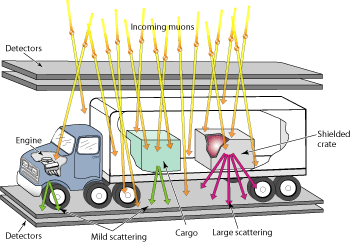

Intel International Science and Engineering Fair
Nov 2016 - May 2017 — Charlotte, North Carolina
Overview:
Muon-scattering tomography (MST) is an imaging technique utilizing cosmic ray elementary particles called muons. The way it works is the trajectory of a muon is measured before and after it passes through some material. While traversing the material in the middle, the muon undergoes multiple-Coulomb scattering events which changes the particle's trajectory by some angle everytime it interacts with atoms. On average of all atoms within the material, the muon's delta in outgoing trajectory will be proportional to the atomic number of the material traversed. In other words, high-Z material like nuclear waste will result in a large change in the muons trajectory, while something carbon-based like a human will result in little-to-no change. By detecting the incoming and outgoing trajectories of many muons, the material in the middle can therefore be imaged.

Fig 1: An application of MST. You can see the two detectors on top detect the incoming trajectory and the two bottom detectors detect the outgoing trajectory. Scans the truck for any unsafe materials.
High maintenance wire chambers and alternative MST methods are proven cost-inefficient, while they are predominantly used by research institutions and universities. Therefore, commercially available MST is unreliable. Rather, the sensing apparatus developed in detecting high-energy muon ionization events would consist of a solid-state volumetric scintillator coupled with a silicon-photomultiplier (SiPM) array. Multiple-Coulomb scattering incidences would be detected by various intensities by the SiPM, thus enabling a trilateration algorithm to determine the position of entry of a muon in each detector. This resulted in a novel MST approach. More information regarding the project can be found in the paper below.
Personal Statement:
I worked on this independent research project on novel MST conducting technique with Trevor Daino and Michael Kronovet our senior year of high school. Our original intentions were to simply build a device which can conduct MST, but it proved difficult due to the high cost and high maintenance of traditional materials used. After many design iterations and consulting professors at a local university, we landed on a design that was within our budget. We spent over two-thousand dollars of our own money and months building our prototype in our garages. We frequently visited the optics laboratory at a local university, consulted academics on our methods, and visited many parts distributors. Countless hours and late nights was put into this project, as there was no 'rubric' we were going off because of our low-cost unconventional design. We decided to enter a local science-fair, and ended up going to the 2017 Intel International Science and Engineering Fair in Los Angeles. We placed 3rd in the Physics and Astronomy category (see video below). Near the end of the project's life-cycle, we ended up filing for a provisional patent for the idea.
This project undoubtedly resulted in one of the best times of my life.
My Contribution:
Group Project (3 members)
Though my friends and I worked on all areas of the project, work was still split up among the three of us.
Due to my extensive experience with electronics, I was the one in charge of of designing all electrical aspects of the project. This included simple biasing circuits for SiPM set-up, a high-speed analog processing circuit to hold measurements from the SiPM (as muon instances lasted for periods as small as a couple nanoseconds), a simple amplifier, and an ADC for data acquisition. Once the short-timed muon pulse was measured by the ADC, a digital signal would be sent to reset the peak-holding circuit to read the next incoming muon. There would be four of these circuits running in parallel for each quadrant of each SiPM, as the ones we used were 2x2 arrays, for a total of 16. Other than electronics, I worked on LTSpice simulations, the Monte-Carlo simulation, material inquiries, prototype construction, testbench assembly, design, and theory. Non-technical contributions included designing both posters, writing the paper (below), and drafting many figures for the former.
Literature:
2017 MST Final ReportMedia Citation(s):
MST truck - https://www.wikipedia.org
ISEF video - https://www.michaelkronovet.com